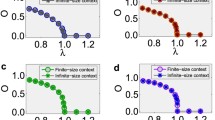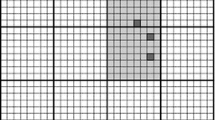Abstract
Properties of “position-space” or “cell-type” renormalization-group transformations from an Ising model object system onto an Ising model image system, of the type introduced by Niemeijer, van Leeuwen, and Kadanoff, are studied in the thermodynamic limit of an infinite lattice. In the case of a KadanofF transformation with finitep, we prove that if the magnetic field in the object system is sufficiently large (i.e., the lattice-gas activity is sufficiently small), the transformation leads to a well-defined set of image interactions with finite norm, in the thermodynamic limit, and these interactions are analytic functions of the object interactions. Under the same conditions the image interactions decay exponentially rapidly with the geometrical size of the clusters with which they are associated if the object interactions are suitably short-ranged. We also present compelling evidence (not, however, a completely rigorous proof) that under other conditions both the finite- and infinite-p (“majority rule”) transformations exhibit peculiarities, suggesting either that the image interactions are undefined (i.e., the transformation does not possess a thermodynamic limit) or that they fail to be smooth functions of the object interactions. These peculiarities are associated (in terms of their mathematical origin) with phase transitions in the object system governed not by the object interactions themselves, but by a modified set of interactions.
Similar content being viewed by others
References
K. G. Wilson and J. Kogut,Phys. Rep. 12C:75 (1974); M. E. Fisher,Rev. Mod. Phys. 46:597 (1974); S.-K. Ma,Modern Theory of Critical Phenomena (Benjamin, Reading, Massachusetts, (1976); C. Domb and M. S. Green, eds.,Phase Transitions and Critical Phenomena (Academic, London, 1976), Vol. 6; D. J. Wallace and R. K. P. Zia,Rep. Prog. Phys. 41:1 (1978).
G. Gallavotti and H. J. F. Knops,Commun. Math. Phys. 36:171 (1974); G. Gallavotti and A. Martin-Löf,Nuovo Cimenta 25B:425 (1975).
D. R. Nelson and M. E. Fisher,Ann. Phys. (N.Y.) 91:226 (1975).
Th. Niemeijer and J. M. J. van Leeuwen,Phys. Rev. Lett. 31:1411 (1973); and inPhase Transitions and Critical Phenomena, C. Domb and M. S. Green, eds. (Academic, London, 1976), Vol. 6, p. 425.
L. P. Kadanoff,Phys. Rev. Lett. 34:1005 (1975).
L. P. Kadanoff, A. Houghton, and M. C. Yalabik,J. Stat. Phys. 14:171 (1976).
H. E. Stanley,Introduction to Phase Transitions and Critical Phenomena (Oxford University Press, 1971), p. 91.
D. Ruelle,Statistical Mechanics: Rigorous Results (Benjamin, New York, 1969).
R. L. Dobrushin,Funct. Anal. Appl. 2:292 (1968).
O. E. Lanford III and D. Ruelle,Commun. Math. Phys. 13:194 (1969).
O. E. Lanford III, inStatistical Mechanics and Mathematical Problems, A. Lenard, ed. (Springer-Verlag, Berlin, 1973), p. 1.
R. B. Griffiths and D. Ruelle,Commun. Math. Phys. 23:169 (1971).
G. Gallavotti and S. Miracle-Sole,Commun. Math. Phys. 7:274 (1968).
D. Ruelle,Ann. Phys. (N. Y.) 25:109 (1963).
H. J. Brascamp,Commun. Math. Phys. 18:82 (1970).
M. Duneauet al., Commun. Math. Phys. 35:307 (1976); M. Duneau and B. Souillard,Commun. Math. Phys. 47:155 (1976).
J. L. Lebowitz and O. Penrose,Commun. Math. Phys. 11:99 (1968).
J. L. Lebowitz,J. Stat. Phys. 16:3 (1977).
L. P. Kadanoffet al., Rev. Mod. Phys. 39:395 (1967); M. E. Fisher,Rep. Prog. Phys. 30:615 (1967).
A. Bienenstock and J. Lewis,Phys. Rev. 160:393 (1967); R. L. Dobrushin,Funct. Anal. Appl. 2:302 (1968).
I. Syozi, inPhase Transitions and Critical Phenomena, C. Domb and M. S. Green, eds. (Academic, London, 1972), Vol. 1, p. 270.
G. A. Baker, Jr. and S. Krinsky,J. Math. Phys. 18:590 (1977).
J. L. Kelley,General Topology (Van Nostrand, Princeton, N.J., 1955).
P. R. Halmos,Measure Theory (Van Nostrand Reinhold, New York, 1950).
G. C. Rota,Z. Wahrscheinlichkeitstheorie 2:340 (1964).
G. Del Grosso,Commun. Math. Phys. 37:141 (1974).
Author information
Authors and Affiliations
Additional information
Supported in part by NSF Grant No. DMR 76-23071.
Rights and permissions
About this article
Cite this article
Griffiths, R.B., Pearce, P.A. Mathematical properties of position-space renormalization-group transformations. J Stat Phys 20, 499–545 (1979). https://doi.org/10.1007/BF01012897
Received:
Issue Date:
DOI: https://doi.org/10.1007/BF01012897




